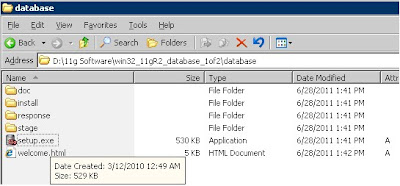Microsoft Windows [Version 5.2.3790](C) Copyright 1985-2003 Microsoft Corp.
C:\Documents and Settings\Administrator>sqlplus
SQL*Plus: Release 10.2.0.1.0 - Production on Fri Feb 3 13:14:42 2012
Copyright (c) 1982, 2005, Oracle. All rights reserved.
Enter user-name: sys as sysdba
Enter password:
Connected to:Oracle Database 10g Enterprise Edition Release 10.2.0.1.0 - Production
With the Partitioning, Oracle Label Security, OLAP and Data Mining Scoring Engine options
SQL> archive log list
Database log mode No Archive Mode
Automatic archival Disabled
Archive destination USE_DB_RECOVERY_FILE_DEST
Oldest online log sequence 54
Current log sequence 56
SQL>
SQL> Disconnected from Oracle Database 10g Enterprise Edition Release 10.2.0.1.0 - Production
With the Partitioning, Oracle Label Security, OLAP and Data Mining Scoring Engine options
C:\Documents and Settings\Administrator>rman
Recovery Manager: Release 10.2.0.1.0 - Production on Fri Feb 3 13:17:45 2012
Copyright (c) 1982, 2005, Oracle. All rights reserved.
RMAN> connect target
connected to target database: STAND(DBID=183739979)
RMAN>
RMAN> show all;
using target database control file instead of recovery catalog
RMAN configuration parameters are:CONFIGURE RETENTION POLICY TO REDUNDANCY 1; # default
CONFIGURE BACKUP OPTIMIZATION OFF; # default
CONFIGURE DEFAULT DEVICE TYPE TO DISK; # default
CONFIGURE CONTROLFILE AUTOBACKUP OFF; # default
CONFIGURE CONTROLFILE AUTOBACKUP FORMAT FOR DEVICE TYPE DISK TO '%F'; # default
CONFIGURE DEVICE TYPE DISK PARALLELISM 1 BACKUP TYPE TO BACKUPSET; # default
CONFIGURE DATAFILE BACKUP COPIES FOR DEVICE TYPE DISK TO 1; # default
CONFIGURE ARCHIVELOG BACKUP COPIES FOR DEVICE TYPE DISK TO 1; # default
CONFIGURE MAXSETSIZE TO UNLIMITED; # default
CONFIGURE ENCRYPTION FOR DATABASE OFF; # default
CONFIGURE ENCRYPTION ALGORITHM 'AES128'; # default
CONFIGURE ARCHIVELOG DELETION POLICY TO NONE; # default
CONFIGURE SNAPSHOT CONTROLFILE NAME TO 'D:\ORACLE\PRODUCT\10.2.0\DB_2\DATABASE\SNCFSTAND.ORA'; # default
RMAN> list backup;
RMAN> list backup summary;
RMAN> backup full database;
Starting backup at 03-FEB-12using channel ORA_DISK_1
channel ORA_DISK_1: starting full datafile backupset
channel ORA_DISK_1: specifying datafile(s) in backupset
RMAN-03009: failure of backup command on ORA_DISK_1 channel at 02/03/2012 13:43:08
ORA-19602: cannot backup or copy active file in NOARCHIVELOG mode
continuing other job steps, job failed will not be re-run
channel ORA_DISK_1: starting full datafile backupset
channel ORA_DISK_1: specifying datafile(s) in backupset
including current control file in backupset
including current SPFILE in backupset
channel ORA_DISK_1: starting piece 1 at 03-FEB-12
channel ORA_DISK_1: finished piece 1 at 03-FEB-12
piece handle=D:\ORACLE\PRODUCT\10.2.0\FLASH_RECOVERY_AREA\STAND\BACKUPSET\2012_02_03\O1_MF_NCSNF_TAG20120203T134307_7LQ7JXY6_.BKP tag=TAG20120203T134307 comment=NONE
channel ORA_DISK_1: backup set complete, elapsed time: 00:00:02
RMAN-00571: ===========================================================
RMAN-00569:
===============
ERROR MESSAGE STACK FOLLOWS
===============
RMAN-00571: ===========================================================
RMAN-03009: failure of backup command on ORA_DISK_1 channel at 02/03/2012 13:43:08
ORA-19602: cannot backup or copy active file in NOARCHIVELOG mode
RMAN> shutdown immediate;
database closed
database dismounted
Oracle instance shut down
RMAN> startup nomount;
connected to target database (not started)
Oracle instance started
Total System Global Area 612368384 bytes
Fixed Size 1250428 bytes
Variable Size 222301060 bytes
Database Buffers 381681664 bytes
Redo Buffers 7135232 bytes
RMAN> backup full database;
Starting backup at 03-FEB-12
allocated channel: ORA_DISK_1channel ORA_DISK_1: sid=157 devtype=DISK
RMAN-00571: ===========================================================
RMAN-00569:
===============
ERROR MESSAGE STACK FOLLOWS
===============
RMAN-00571: ===========================================================
RMAN-03002: failure of backup command at 02/03/2012 13:44:36
ORA-01507: database not mounted
RMAN> alter database mount;
database mounted
released channel: ORA_DISK_1
RMAN> backup full database;
Starting backup at 03-FEB-12allocated channel: ORA_DISK_1
channel ORA_DISK_1: sid=156 devtype=DISK
channel ORA_DISK_1: starting full datafile backupset
channel ORA_DISK_1: specifying datafile(s) in backupset
input datafile fno=00006 name=D:\ORACLE\PRODUCT\10.2.0\ORADATA\STAND\STAND.DBF
input datafile fno=00007 name=D:\ORACLE\PRODUCT\10.2.0\ORADATA\STAND\INDX.DBF
input datafile fno=00001 name=D:\ORACLE\PRODUCT\10.2.0\ORADATA\STAND\SYSTEM01.DBF
input datafile fno=00003 name=D:\ORACLE\PRODUCT\10.2.0\ORADATA\STAND\SYSAUX01.DBF
input datafile fno=00002 name=D:\ORACLE\PRODUCT\10.2.0\ORADATA\STAND\UNDOTBS01.DBF
input datafile fno=00005 name=D:\ORACLE\PRODUCT\10.2.0\ORADATA\STAND\EXAMPLE01.DBF
input datafile fno=00004 name=D:\ORACLE\PRODUCT\10.2.0\ORADATA\STAND\USERS01.DBF
channel ORA_DISK_1: starting piece 1 at 03-FEB-12
channel ORA_DISK_1: finished piece 1 at 03-FEB-12
piece handle=D:\ORACLE\PRODUCT\10.2.0\FLASH_RECOVERY_AREA\STAND\BACKUPSET\2012_02_03\O1_MF_NNNDF_TAG20120203T134503_7LQ7NJHZ_.BKP tag=TAG20120203T134503 comment=NONE
channel ORA_DISK_1: backup set complete, elapsed time: 00:03:35
channel ORA_DISK_1: starting full datafile backupset
channel ORA_DISK_1: specifying datafile(s) in backupset
including current control file in backupset
including current SPFILE in backupset
channel ORA_DISK_1: starting piece 1 at 03-FEB-12
channel ORA_DISK_1: finished piece 1 at 03-FEB-12
piece handle=D:\ORACLE\PRODUCT\10.2.0\FLASH_RECOVERY_AREA\STAND\BACKUPSET\2012_02_03\O1_MF_NCSNF_TAG20120203T134503_7LQ7V9WJ_.BKP tag=TAG20120203T134503 comment=NONE
channel ORA_DISK_1: backup set complete, elapsed time: 00:00:03
Finished backup at 03-FEB-12
RMAN> backup current controlfile;
Starting backup at 03-FEB-12
allocated channel: ORA_DISK_1
channel ORA_DISK_1: sid=156 devtype=DISK
channel ORA_DISK_1: starting full datafile backupset
channel ORA_DISK_1: specifying datafile(s) in backupset
including current control file in backupset
channel ORA_DISK_1: starting piece 1 at 03-FEB-12
channel ORA_DISK_1: finished piece 1 at 03-FEB-12
piece handle=D:\ORACLE\PRODUCT\10.2.0\FLASH_RECOVERY_AREA\STAND\BACKUPSET\2012_02_03\O1_MF_NCNNF_TAG20120203T140027_7LQ8KDTF_.BKP tag=TAG20120203T140027 comment=NONE
channel ORA_DISK_1: backup set complete, elapsed time: 00:00:01Finished backup at 03-FEB-12
RMAN> sql 'alter database backup controlfile to trace';
sql statement: alter database backup controlfile to trace
RMAN> sql 'create pfile from spfile';
sql statement: create pfile from spfile
RMAN>























